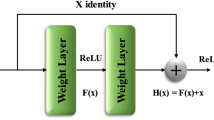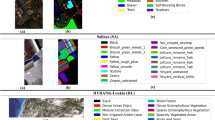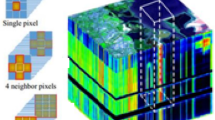Abstract
Deep learning methods have played a prominent role in the development of computer visualization in recent years. Hyperspectral imaging (HSI) is a popular analytical technique based on spectroscopy and visible imaging which examines the pattern of light in a target and recognizes objects based on varying spectral properties. However, in remote sensing, detecting surface material via HSI analysis is a critical and difficult task. The performance of spectral-spatial data exploitation is well established to outperform typical spectral pixel-wise techniques. Because of its great feature extraction ability, convolutional neural networks (CNN) have emerged as a potent deep learning approach. CNN translates the input features of an image into an equivalent CNN feature map, in addition to naturally combining spectral and spatial information. However, spectral-spatial properties when combined with pixel-wise extraction can learn more minute details of objects present on the earth’s terrain. In this paper, a noble Composite Spectral Spatial Pixel CNN model for the classification of hyperspectral data is presented which is an amalgamation of 3D-2D-1D CNN. While the 3D and 2D CNN exploit the spectral-spatial features effectively, 1D CNN works on pixel-wise feature extraction. Further, to optimize the classification performance of the proposed model, a new hybrid activation function Flatten-T Swish is also used which is the combination of ReLU and Swish function. The proposed model is compared with other state-of-the-art models based on three popular HSI datasets, and it is found that the proposed model performs better among others in terms of classification and computation time, giving 98.87% accuracy for Indian Pines, 99.92% accuracy for Pavia University, and 99.99% accuracy for Salinas Valley dataset.













Similar content being viewed by others
Data Availability
The data used for experimentation is available publicly.
References
Xu Y, Wu Z, Wei Z (2015) Spectral–spatial classification of hyperspectral image based on low-rank decomposition. IEEE J Sel Top Appl Earth Obs Remote Sens 8(6):2370–2380. https://doi.org/10.1109/JSTARS.2015.2434997
Guo Y et al (2021) Integrated phenology and climate in rice yields prediction using machine learning methods. Ecol Indic 120:106935. https://doi.org/10.1016/j.ecolind.2020.106935
Azarafza M, Nanehkaran YA, Akgun H, Mao Y (2021) Application of an image processing-based algorithm for river-side granular sediment gradation distribution analysis. Adv Mater Res 10(3):229–244
Nikoobakht S, Azarafza M, Akgun H, Derakhshani R (2022) Landslide susceptibility assessment by using convolutional neural network. Appl Sci 12(12):5992. https://doi.org/10.3390/app12125992
Hasanlou M, Samadzadegan F (2012) Comparative study of intrinsic dimensionality estimation and dimension reduction techniques on hyperspectral images using K-NN classifier. IEEE Geosci Remote Sens Lett 9(6):1046–1050. https://doi.org/10.1109/LGRS.2012.2189547
Lv W (2020) Overview of hyperspectral image classification. J Sens 2:1–13. https://doi.org/10.1155/2020/4817234
Ma A, Filippi AM, Wang Z, Yin Z (2019) Hyperspectral Image Classification Using Similarity Measurements-Based Deep Recurrent Neural Networks. Remote Sens 11(2):194. https://doi.org/10.3390/rs11020194
Mou L, Ghamisi P, Zhu XX (2017) Deep recurrent neural networks for hyperspectral image classification. IEEE Trans Geosci Remote Sens 55(7):3639–3655. https://doi.org/10.1109/TGRS.2016.2636241
Swain S, Bandyopadhyay M, Satapathy SC (2021) Dimensionality Reduction and Evaluation in Hyperspectral Images using LSTM Models. Int Conf Range Technol 1–6. https://doi.org/10.1109/ICORT52730.2021.9582080
Gao P, Wang J, Zhang H, Li Z (2018) Boltzmann entropy-based unsupervised band selection for hyperspectral image classification. IEEE Geosci Remote Sens Lett 16(3):462–466. https://doi.org/10.1109/LGRS.2018.2872358
Ning X, Tian W, He F, Bai X, Sun L, Li W (2023) Hyper-sausage coverage function neuron model and learning algorithm for image classification. Pattern Recognit 136:109216. https://doi.org/10.1016/j.patcog.2022.109216
Ning X, Tian W, Yu Z, Li W, Bai X, Wang Y (2022) HCFNN: High-order coverage function neural network for image classification. Pattern Recognit 131:108873. https://doi.org/10.1016/j.patcog.2022.108873
Ahmad M et al (2021) Hyperspectral image classification—Traditional to deep models: A survey for future prospects. IEEE J Sel Top Appl Earth Obs Remote Sens 15:968–999. https://doi.org/10.1109/JSTARS.2021.3133021
Makantasis K, Karantzalos K, Doulamis A, Doulamis N (2015) Deep supervised learning for hyperspectral data classification through convolutional neural networks. IEEE Int Geosci Remote Sens Symp 2015:4959–4962. https://doi.org/10.1109/IGARSS.2015.7326945
Melgani F, Bruzzone L (2004) Classification of hyperspectral remote sensing images with support vector machines. IEEE Trans Geosci Remote Sens 42(8):1778–1790. https://doi.org/10.1109/TGRS.2004.831865
Shenming Q, Xiang L, Zhihua G (2022) A new hyperspectral image classification method based on spatial-spectral features. Sci Rep 12(1):1541. https://doi.org/10.1038/s41598-022-05422-5
Bo C, Lu H, Wang D (2018) Spectral-spatial K-Nearest Neighbor approach for hyperspectral image classification. Multimed Tools Appl 77:10419–10436. https://doi.org/10.1007/s11042-017-4403-9
Qian Y, Ye M, Zhou J (2012) Hyperspectral image classification based on structured sparse logistic regression and three-dimensional wavelet texture features. IEEE Trans Geosci Remote Sens 51(4):2276–2291. https://doi.org/10.1109/TGRS.2012.2209657
Zhou Y, Peng J, Chen CP (2014) Dimension reduction using spatial and spectral regularized local discriminant embedding for hyperspectral image classification. IEEE Trans Geosci Remote Sens 53(2):1082–1095. https://doi.org/10.1109/TGRS.2014.2333539
Guo Y, Qu F, Yu Z, Yu Q (2020) Deep LSTM with Guided Filter for Hyperspectral Image Classification. Comput Inform 39(5):973–993. https://doi.org/10.31577/cai_2020_5_973
Mei S, Li X, Liu X, Cai H, Du Q (2021) Hyperspectral image classification using attention-based bidirectional long short-term memory network. IEEE Trans Geosci Remote Sens 60:1–12. https://doi.org/10.1109/TGRS.2021.3102034
Banerjee A, Banik D (2023) Pooled hybrid-spectral for hyperspectral image classification. Multimed Tools Appl 82:10887–10899. https://doi.org/10.1007/s11042-022-13721-2
Hu WS, Li HC, Pan L, Li W, Tao R, Du Q (2020) Spatial–spectral feature extraction via deep ConvLSTM neural networks for hyperspectral image classification. IEEE Trans Geosci Remote Sens 58(6):4237–4250. https://doi.org/10.1109/TGRS.2019.2961947
Chen S, Jin M, Ding J (2021) Hyperspectral remote sensing image classification based on dense residual three-dimensional convolutional neural network. Multimed Tools Appl 80:1859–1882. https://doi.org/10.1007/s11042-020-09480-7
Zhong H, Li L, Ren J, Wu W, Wang R (2022) Hyperspectral image classification via parallel multi-input mechanism-based convolutional neural network. Multimed Tools Appl 81:24601–24626. https://doi.org/10.1007/s11042-022-12494-y
Hu F, Xia GS, Hu J, Zhang L (2015) Transferring deep convolutional neural networks for the scene classification of high-resolution remote sensing imagery. Remote Sens 7(11):14680–14707. https://doi.org/10.3390/rs71114680
Chen Y, Jiang H, Li C, Jia X, Ghamisi P (2016) Deep feature extraction and classification of hyperspectral images based on convolutional neural networks. IEEE Trans Geosci Remote Sens 54(10):6232–6251. https://doi.org/10.1109/TGRS.2016.2584107
Hamida AB, Benoit A, Lambert P, Amar CB (2018) 3-D deep learning approach for remote sensing image classification. IEEE Trans Geosci Remote Sens 56(8):4420–4434. https://doi.org/10.1109/TGRS.2018.2818945
He M, Li B, Chen H (2017) Multi-scale 3D deep convolutional neural network for hyperspectral image classification. IEEE Int Conf Image Process 2017:3904–3908. https://doi.org/10.1109/ICIP.2017.8297014
Roy SK, Krishna G, Dubey SR, Chaudhuri BB (2019) HybridSN: Exploring 3-D–2-D CNN feature hierarchy for hyperspectral image classification. IEEE Geosci Remote Sens Lett 17(2):277–281. https://doi.org/10.1109/LGRS.2019.2918719
Bandyopadhyay M (2021) Multi-stack hybrid CNN with non-monotonic activation functions for hyperspectral satellite image classification. Neural Comput Appl 33(21):14809–14822. https://doi.org/10.1007/s00521-021-06120-5
Zhong Z, Li J, Luo Z, Chapman M (2017) Spectral–spatial residual network for hyperspectral image classification: A 3-D deep learning framework. IEEE Trans Geosci Remote Sens 56(2):847–858. https://doi.org/10.1109/TGRS.2017.2755542
Mou L, Ghamisi P, Zhu XX (2017) Unsupervised spectral–spatial feature learning via deep residual Conv–Deconv network for hyperspectral image classification. IEEE Trans Geosci Remote Sens 56(1):391–406. https://doi.org/10.1109/TGRS.2017.2748160
Roy SK, Chatterjee S, Bhattacharyya S, Chaudhuri BB, Platos J (2020) Lightweight spectral–spatial squeeze-and-excitation residual bag-of-features learning for hyperspectral classification. IEEE Trans Geosci Remote Sens 58(8):5277–5290. https://doi.org/10.1109/TGRS.2019.2961681
Zhong C, Zhang J, Zhang Y (2020) Multiscale feature extraction based on convolutional sparse decomposition for hyperspectral image classification. IEEE J Sel Top Appl Earth Obs Remote Sens 13:4960–4972. https://doi.org/10.1109/JSTARS.2020.3019300
Li W, Prasad S, Fowler JE (2013) Hyperspectral image classification using Gaussian mixture models and Markov random fields. IEEE Geosci Remote Sens Lett 11(1):153–157. https://doi.org/10.1109/LGRS.2013.2250905
Patel H, Upla KP (2022) A shallow network for hyperspectral image classification using an autoencoder with convolutional neural network. Multimed Tools Appl 81:695–714. https://doi.org/10.1007/s11042-021-11422-w
He Z, Liu H, Wang Y, Hu J (2017) Generative adversarial networks-based semi-supervised learning for hyperspectral image classification. Remote Sens 9(10):1042. https://doi.org/10.3390/rs9101042
Sellami A, Tabbone S (2022) Deep neural networks-based relevant latent representation learning for hyperspectral image classification. Pattern Recognit 121:108224. https://doi.org/10.1016/j.patcog.2021.108224
Yao D et al (2023) Deep hybrid: multi-graph neural network collaboration for hyperspectral image classification. Def Technol 23:164–176. https://doi.org/10.1016/j.dt.2022.02.007
Ibanez D, Fernandez R, Pla F, Yokoya N (2022) Masked Auto-Encoding Spectral-Spatial Transformer for Hyperspectral Image Classification. IEEE Trans Geosci Remote Sens 60:1–14. https://doi.org/10.1109/TGRS.2022.3217892
Mekala S, Rani BP (2020) Kernel PCA based dimensionality reduction techniques for preprocessing of Telugu text documents for cluster analysis. Int J Adv Res Eng Technol 11(11):1337–1352. https://doi.org/10.34218/IJARET.11.11.2020.121
Scholkopf B, Smola A, Muller K (1997) Kernel Principal Component Analysis. In: Gerstner W, Germond A, Hasler M, Nicoud JD (eds) Artif Neural Net 1327. Springer, Heidelberg. https://doi.org/10.1007/BFb0020217
Swain S, Banerjee A (2021) Evaluation of dimensionality reduction techniques on hybrid CNN–based HSI classification. Arab J Geosci 14:2806. https://doi.org/10.1007/s12517-021-09143-3
Ranjan P, Girdhar A (2023) Deep Siamese Network with Handcrafted Feature Extraction for Hyperspectral Image Classification. Multimed Tools Appl. https://doi.org/10.1007/s11042-023-15444-4
Gao J, Gao X, Wu N, Yang H (2022) Bi-directional LSTM with multi-scale dense attention mechanism for hyperspectral image classification. Multimed Tools Appl 81:24003–24020. https://doi.org/10.1007/s11042-022-12809-z
Funding
No funding support has been received by any means from any organization.
Author information
Authors and Affiliations
Corresponding author
Ethics declarations
Competing Interests
The authors would like to declare no competing interest in the submitted manuscript.
Additional information
Publisher's Note
Springer Nature remains neutral with regard to jurisdictional claims in published maps and institutional affiliations.
Rights and permissions
Springer Nature or its licensor (e.g. a society or other partner) holds exclusive rights to this article under a publishing agreement with the author(s) or other rightsholder(s); author self-archiving of the accepted manuscript version of this article is solely governed by the terms of such publishing agreement and applicable law.
About this article
Cite this article
Banerjee, A., Swain, S., Rout, M. et al. Composite spectral spatial pixel CNN for land-use hyperspectral image classification with hybrid activation function. Multimed Tools Appl (2024). https://doi.org/10.1007/s11042-024-19327-0
Received:
Revised:
Accepted:
Published:
DOI: https://doi.org/10.1007/s11042-024-19327-0




